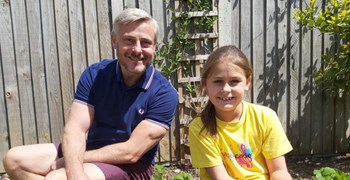09/06/2020
5 Minutes with Colin Tebb, Chairman of Essex HMVA
To celebrate the launch of our new Club Classic Vehicle Insurance scheme, we’re speaking to classic vehicle owners to find out more about their passion. From scrapyard finds to lifelong hobbies, we get under the skin of classic vehicle ownership.
In this, the first article, we speak to the Essex Historic Military Vehicle Association’s (HMVA) Chairman, Colin Tebb, about his British military vehicles.
Can you tell us a bit about your vehicles?
I own two. Both are Bedfords and both are 3-ton trucks. They are also World War 2 vintage army vehicles. I get around 8-10 miles a gallon from them; in four-wheel-drive that goes down to about 3 miles a gallon.
One is a Bedford QLB, a Bofors anti-aircraft gun tractor, which was manufactured in 1941. The other one is a Bedford QLT, which is a troop carrier, which dates from 1942.
During the war, the QL was the series of vehicles that Bedford manufactured as a 3t 4x4 lorry. They used the same cabin chassis and put various different bodies on the back.
How did you come across your military vehicles?
To give some context, I worked at Duxford as a volunteer at the Imperial War Museum and there I discovered that people privately owned these vehicles. At the time I was unaware you could do that.
I started looking around and found the Bedford QLB was in a scrapyard near Braintree in Essex. I wasn’t really looking for a QLB because they are so rare. I didn’t seriously think I would ever find one. A friend called me up to say that he had found one in a scrapyard with a ‘for sale’ sign on it. We happened to be in the right place at the right time, to cut a long story short.
The other one was quite a funny story. I happened to be in a book shop at one of the Duxford shows and overheard someone looking for a manual for a Bedford QL, as I was. He told me he had a Bedford QLT that he wanted to sell, which happened to be what I was looking for. So that’s how I acquired that one.
Did you have to do much work to get them on the road?
With British engineering, it’s all unusual, especially from that period. You’ve got to bear in mind that these trucks were being made in 1941 with many pre-war components. We [the British] had our backs to the wall; we were going through a pretty bad time. Vehicles needed to be manufactured and put into service as quickly as they could. Things like accessibility and, to some extent reliability, were probably not priorities, which can make them difficult to work on. Also, the engines were underpowered, even for the era, which can make them interesting to drive.
I did have to do quite a lot to the QLB. It was roadworthy, but the back was a replica, so I stripped that off with a friend and rebuilt it with original parts. We managed to find about 95%.
Read more: Meet the Club Classic team
I managed to find the major components in someone’s shed. Again, it was amazing, considering the rarity of the vehicles. I found two complete backs for them in two different sheds. One was several hundred feet from where I keep the truck, and the other was in Rickmansworth.
Every classic vehicle owner has stories to tell. Our experiences allow us to create stories about restoration projects and interactions. I’m not sure if you ever really finish working on a classic vehicle. There is always something that needs doing; that’s part of the fun of owning them.
What makes these vehicles special?
While they’re rare, it’s not so much about that for me. I think it’s more that they’re World War 2 vintage, British and played a major role in a historical event which makes them special for me. Meeting veterans, both WW2 and National Service, who used them is also informative; I’ve found out a lot by talking to them.
The Bedford QL was the first four-wheel-drive 3t lorry used by the British Army so it has an interest there. Also, the QLB is fitted with a 3t winch integrated into the chassis, which was an unusual design back then.
Plus, they’re great fun and have lots of character.
Did your military vehicles see active service?
My vehicles were used during the Second World War. By their definition and their age, they would have seen active service.
The QLB was built pretty much in the first year of manufacture of the Bedford QL and I have managed to find some of the original paint on it, which confirms that. It’s got a story to tell, but I can’t find any specific information about it. Given that it towed an anti-aircraft gun, the QLB model was probably used in all theatres of war.
The QLT was the main troop transport vehicle throughout the war. I know mine spent a lot of time in Germany. In fact, it was de-mobbed in Germany in 1962. Most of the vehicles of that vintage went over around D-Day and stayed there.
How do you use your Bedfords now?
We attend events, local fetes and things like that, along with vehicle rallies, open days and charity events if that’s needed.
They’ve also done some film work. They were in Danger UXB, which was a TV series. The Monuments Men with George Clooney was the last one; both trucks were in that.
As a club, we rent a barn. My own vehicles and several members’ vehicles are stored there. It’s a great member benefit.
Tell us more about being a member of the Essex HMVA.
The Essex HMVA formed around 6 years ago and we have more than 200 members now. They’re not just in Essex; we now have members across the UK and Europe. We have lots of members with lots of knowledge.
It’s nice because we’re an independent club and a registered charity but we have the cover and protection of a large club. You do not have to own a vehicle to be a member. In fact, many members do not own vehicles but have a keen interest in military history and artefacts; they find our publications interesting and informative.
We have a newsletter that goes out online; we have a quarterly magazine, with vehicle and military history info and articles; we’ve got a comprehensive website, with a members’ only section; we’ve got a Facebook Page… We’ve got lots of ways to stay in touch.
Of course, we run our own events too. Our main one is Echoes of History, which is held just outside Maldon in Essex. With several hundred military vehicles in attendance, plus lots of other activities including tank rides, classic cars, collectors stalls, flypasts by the RAF BBMF [Battle of Britain Memorial Flight] and so on. It’s a great thing for us to do. Members get into that one free.
We also support Armed Forces Day events at various locations in Essex, but we arrange our own one in conjunction with Maldon Council. In January we run the Winter Gathering, also known as the ‘Bum Freezer’, again in Maldon. That one has a large classic car club attendance too.
If money was no object, which military vehicle would you buy?
It changes weekly! If I’m at a show, it changes every half-hour! Whatever one I’m looking at that moment is the one I’d like. I would love a bit of British armour though, like a Cromwell tank, or something like that. I also love post-war armoured cars, so I would be rather happy with one of those.
One of the things we offer, as a club, is vehicle authentication for the DVLA. When someone’s restoring a vehicle and they need help to get it taxed they ask us. We are able to confirm to the DVLA it’s a 1944 Sherman tank and not a Ford Escort, for instance. Basically, it’s a requirement if you want to get something taxed for the road. A lot of the vehicles we inspect tend to be ex-military Jeeps, trucks and armoured vehicles dating from the 40s to the 70s. I recently inspected a 1950’s Saracen armoured car. It was great. I’d love to have that.
If you own a military vehicle, or are a member of a military vehicle owners club, get in touch. We’d love to hear more about them and discuss your military vehicle insurance requirements. Call on 03300 552659.
Related Articles





